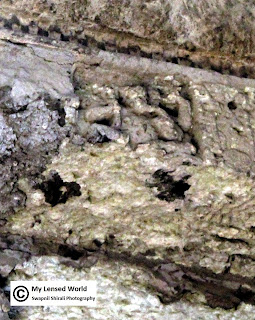JOGESHWARI CAVES AND MUMBAI'S OLDEST GANAPATI
The Ganesh Chaturthi is undoubtedly the most popular
festival in India especially in its western parts. The festival is celebrated
with much pomp and ceremony for over 10 days all over Mumbai. In the
overcrowded suburb of Jogeshwari under a mountain surrounded by slums sits the
oldest murti of Lord Ganapati showing contrasting picture of the ornamented
decorations of Ganapati celebrations in the city to the dilapidated cave temple of
Jogeshwari.
Since the 2nd century, rock cut caves were dug
and carved from the basalt rock of the hills in the Deccan plateau. The
practice reached its zenith in the 5th century AD under Vakataka
dynasty which ruled the Deccan region. As patrons of art, the world famous
Ajanta caves were built during the reign of Vakataka king Harisena. After
his death the dynasty did not last long and there were internal rivalries and the
entire kingdom was disorganised. During this period it seems that some artisans
travelled to the western parts of Maharashtra which was ruled by Kalachuris.
The earliest known ruler of the Kalachuri dynasty was Krishnaraja. Historical
evidence throws light on the development of caves at Jogeshwari followed by
Elephanta in this part of the world. The Kalachuris being Shaivite dedicated the caves to Lord Shiva. The caves at Ellora were also developed in this
period.
Walter Spink, art historian at the University of Michigan
accounts Jogeshwari caves as the ‘first largest Hindu cave temple’. However the
once richly ornamented cave temple has lost its glory and its condition has deteriorated over a period of
neglect and encroachments. The site is now surrounded by slums while sewage
runs through the caves further hurting its foundations. Walter Spink had visited
the site in 1960 and mentioned about the sewage, slums and being a place for
drinking and drugs at night. Today however the site is protected by
Archaeological Survey of India.
Jogeshwari caves can be easily located at the western express
highway on the Jogeshwari Vikroli link road. The main entrance goes through a
passage cut from solid rock measuring 8 feet wide and 50 feet long. This passage
with the help of six steps leads to a small chamber of 20 feet by 18 feet and
20 feet wide. This chamber has the main door to the cave temple. The door has 2 dwarpalas in a dilapidated condition. The two smaller chambers to the sides
had 2 pillars completely withered away in the course of time. The right chamber
had carving of Lord Shiva while the left had Lord Shiva in tandav position.
The central door opens to an immense hall of 90 feet high,
dark even in the middle of the day. The hall has 20 pillars, 6 on each side
dividing the hall in 4 aisles. Within the central hall is a temple of Goddess
Jogehwari or Yogeshwari after whom the area is know today. To the right are 2
side doorways, 2 windows and 1 central doorway. This doorway opens to a
verandah, 16 feet broad and 120 feet long whose outer area is supported by a row
of 10 pillars and 2 pillasters. The wall of the door also has some rich
carvings. Beyond the verandah is an open court with carvings and cells. There is
a temple of Lord Shiva and Lord Hanuman here including an incomplete carving of
a goddess.
 |
| Game of dice between Lord Shiva and Goddess Parvati |
The main hall has another door on the eastern side which
seems to be the main entrance in the ancient times. This door is attended by
Dwarpalas and dwarfs. Above this door there are 3 sections of carvings
pertaining to Lord Shiva. The top middle section is Lord Shiva worshipped by
followers, the top left is Kalyansundar murti i.e the marriage of Lord Shiva
and Goddess Parvati in presence of Lord Brahma officiating as priest and Lord
Vishnu. The severed head of Daksha can also be seen in the carving. The top
right section is a game of dice between Lord Shiva and Goddess Parvati.
 |
| Nataraja |
An exit from this hall leads to another open courtyard of 42
feet by 6 feet. The exit door has a rich intricate carving of Nataraja on the
top, much defaced over the course of time. The door is also richly ornamented with
figures including dwarpalas on either side. This courtyard leads to another hall
about 30 feet by 18 feet with 2 side chambers of 4 pillars and 2 pilasters. Here
the oldest Ganapati Murti can be seen painted in florescent orange. There is a
rock cut passage here rising by a flight of 30 steps having a Ravananugraha
carving in which Ravan tries to shake Kailas mountain although much destroyed
today.
The Jogeshwari caves is the largest cave complex in India
after Ellora. Its sheer length of 320 feet and breadth of 200 feet carved under
a mountain makes it an extraordinary architectural wonder cut from solid rock
with hammer and chisel only. Inspite of this fact, these caves are fighting for
survival from the increasing onslaught of man.
GALLERY:
 |
| Entrance |
 |
| Main hall |
 |
| Dwarpala |
 |
| Dwarpala |
 |
| Kalyansundar murti |
 |
| Unfinished carving of a goddess |


























1 comment:
Congratulations Swapnil Shirali..for blog has been proven to be so important for the residents & guests of Mumbai..it ll definitely help us to explore Mumbai more enthusiastically..& definitely it ll help us to see Mumbai beyond financial capital of India..
Post a Comment